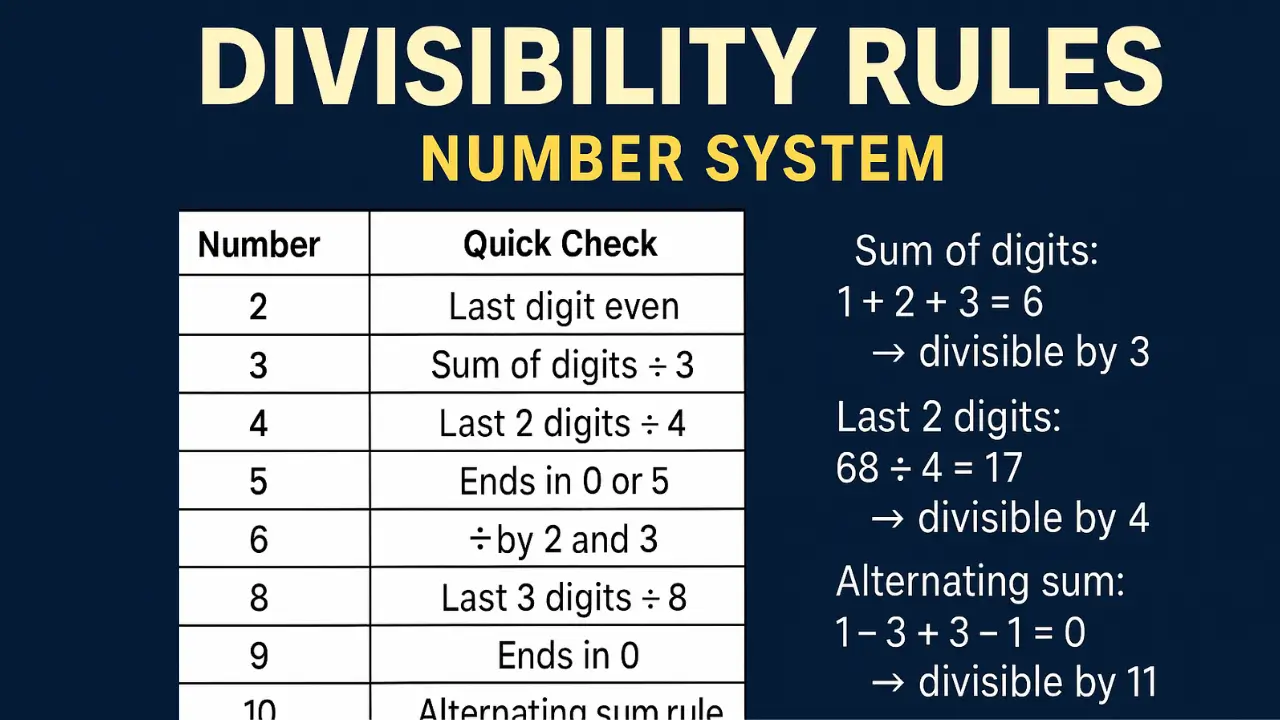📌 What are Divisibility Rules?
Divisibility rules are shortcuts or tricks that help you check whether one number is divisible by another. For example, you can check if a number is divisible by 2, 3, 5, 7, etc., without actual division.
🧮 Divisibility Rules from 1 to 20:-
| Number | Divisibility Rule | Example |
|---|---|---|
| 1 | Every number is divisible by 1 | 25 ÷ 1 = 25 |
| 2 | If the last digit is even (0, 2, 4, 6, 8) | 48 is divisible by 2 |
| 3 | If the sum of digits is divisible by 3 | 123 → 1+2+3=6 → divisible by 3 |
| 4 | If the last 2 digits form a number divisible by 4 | 516 → last 2 digits = 16 → divisible by 4 |
| 5 | If the number ends in 0 or 5 | 75 is divisible by 5 |
| 6 | If the number is divisible by both 2 and 3 | 60 is divisible by 2 and 3 |
| 7 | Double the last digit, subtract from the rest, check result divisible by 7 | 203 → 20 – (2×3) = 14 → divisible by 7 |
| 8 | If the last 3 digits form a number divisible by 8 | 1112 → last 3 digits = 112 → divisible by 8 |
| 9 | If the sum of digits is divisible by 9 | 729 → 7+2+9 = 18 → divisible by 9 |
| 10 | If the number ends with 0 | 90 is divisible by 10 |
| 11 | Alternate sum of digits (odd-even positions), check difference divisible by 11 | 121 → 1 – 2 + 1 = 0 → divisible by 11 |
| 12 | If divisible by both 3 and 4 | 144 is divisible by 3 and 4 |
| 13 | Multiply the last digit by 9, subtract from rest; check result | 351 → 35 – (9×1) = 26 → divisible by 13 |
| 14 | If divisible by both 2 and 7 | 98 is divisible by 2 and 7 |
| 15 | If divisible by both 3 and 5 | 60 is divisible by 3 and 5 |
| 16 | If the last 4 digits are divisible by 16 | 6160 → 6160 is divisible by 16 |
| 17 | Multiply last digit by 5, subtract from rest | 221 → 22 – (5×1) = 17 → divisible by 17 |
| 18 | If divisible by both 2 and 9 | 162 is divisible by 2 and 9 |
| 19 | Multiply last digit by 2, add to the rest; result divisible by 19 | 133 → 13 + (2×3) = 19 |
| 20 | If number ends in 00, 20, 40, 60, 80 | 240 is divisible by 20 |
🎯 Why Are Divisibility Rules Important?
- Saves time in competitive exams
- Helps in simplification, LCM, HCF, and factorization
- Essential for solving number-based puzzles
- Useful in identifying prime and composite numbers
🔍 Divisibility Rules Chart (Quick View):-
Here’s a quick-reference chart you can save or print for exam revision:
| Number | Quick Check Method |
| 2 | Last digit is ‘0’ or Even |
| 3 | Sum of Digits is divisible by 3 |
| 4 | Number made by last two digits is divisible by 4 |
| 5 | Last digit is ‘0’ or ‘5’ |
| 6 | Divisible by both ‘2’ and ‘3’ |
| 8 | Number made by last three digits is divisible by 8 |
| 9 | Sum of Digits is divisible by 9 |
| 10 | Last digit is ‘0’ |
| 11 | Difference of Odd places and Even places digits sums is either ‘0’ or is a multiple of ’11’ |
| 12 | Divisible by both ‘3’ and ‘4’ |
📘 Examples Using Divisibility Rules:-
Let’s go through some examples:
Example 1: Is 234 divisible by 3?
Sum of digits: 2 + 3 + 4 = 9 → 9 is divisible by 3 → Yes
Example 2: Is 468 divisible by 4?
Last 2 digits: 68 → 68 ÷ 4 = 17 → Yes
Example 3: Is 1331 divisible by 11?
Alternating sum: 1 – 3 + 3 – 1 = 0 → 0 is divisible by 11 → Yes
Example 4: Is 154 divisible by 7?
15 – (2×4) = 15 – 8 = 7 → 7 is divisible by 7 → Yes
🧠 Practice Questions:-
Try these and apply the rules:
- Is 234 divisible by 6?
- Is 729 divisible by 9?
- Is 1120 divisible by 8?
- Is 95 divisible by 5 and 19?
- Is 141 divisible by 3 and 11?
✅ Answers to Practice Questions:-
- 234 → divisible by 2 (yes), sum of digits = 9 → divisible by 3 → ✅ Yes
- 7 + 2 + 9 = 18 → 18 ÷ 9 = 2 → ✅ Yes
- Last 3 digits: 120 → 120 ÷ 8 = 15 → ✅ Yes
- Ends in 5 → divisible by 5, 9 + (2×5) = 95 → 9 + 10 = 19 → ✅ Yes
- 1+4+1 = 6 → divisible by 3, alternate sum = 1 – 4 + 1 = -2 → ❌ No
📝 Tips to Remember Divisibility Rules:-
- Learn in pairs: like 2 & 4, 3 & 9, 5 & 10
- Practice with 3-digit and 4-digit numbers
- Create your own short notes
- Practice mental math using these rules
- Use divisibility rules to check prime numbers
📈 Real-Life Applications of Divisibility Rules:-
- Banking exams: Number series, simplification
- Accounting: For verifying divisibility in budgets
- Computer Science: Data chunking, binary/decimal conversion
- Daily life: Distributing items, managing budgets, splitting bills
🔚 Conclusion:-
Mastering the divisibility rules will give you an edge in all arithmetic-based exams. These rules are not only quick to use but also help you avoid unnecessary long calculations. Practice regularly, use the tips and charts above, and soon you’ll be solving number system problems faster than ever!
Let us know in the comments if you want a downloadable PDF chart of divisibility rules!
**You Might Also Like:
- Must-Know Algebra Formulas for Competitive Exams with Examples & Questions
- Percentage Important Concepts
- Simple Interest Practice Questions Set 01 – For Govt Job & Academic Exams
Follow Us on Facebook:
Stay updated with the latest math practice sets, tips, and exam strategies. Follow Mathsmine on Facebook for Daily Updates







